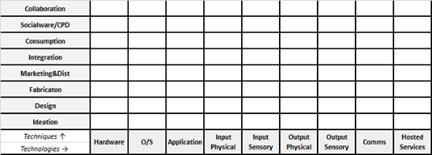Ideation
The process of generating ideas or inspiration for creativity prior to formal design - e.g. mindmaps, sketching
Design
The formal process of creating a design e.g. drawing, CAD
Fabrication
The process of creating an artefact e.g. prototyping, publishing, printing or creating multiple copies of it.
Marketing & Distribution
The process of understanding and engaging the end user, making the artefact available to end users, features, user testing/experience.
Integration
The process of integrating 2 or more stages of the Architecture lifecycle such as Ideation and Design or Idea to Consumption, Sketch to Reality.
Consumption
The process of using/buying/deploying the architecture or model in reality.
Socialware/Continuing Professional Development (CPD)
How people evolve in response to architectural technology or affordances, Awareness, Intermediary Business, ICT and Design roles, Knowledge, Hubs, Knowledge Bases/Repositories, Discussion, Communication and Sharing, including training and CPD.
Collaboration
The process of Collaborating around Standards and Convergence. Interoperability, Vendor-Client relations and exchange. Individual, Community or Societal Analysis/Research, Addressing Obsolescence, Flexibility, Adaptability, Modularity, Service Design. |
Hardware
Technology which is physical and has processing capabilities e.g. PC, Mac, Smartphone.
Operating System (O/S)
The underlying software platform e.g. Windows, IOS, Android, Middleware
Application
Software applications that are used in the creative process or by the end user e.g. CAD software such as AutoCAD, BIM software, Rhino, Adobe Suite, Photoshop, Maya and Illustrator. Development of interfaces or tools for improved Architecture processes.
Input Physical
Devices which are used to physically interface with the technology e.g. mouse, keyboard, console
Input Sensory
Technology which provides input based on sensors e.g. cameras, eye trackers, Leap motion, 3D scanners
Output Physical
Technology which outputs a physical artefact e.g. 3D printers used in fabrication and prototyping
Output Sensory
Technology which outputs in a virtual sensory format e.g. Displays, VR Headsets, AR Displays, tactile/haptic feedback, audio.
Communications (Comms)
Technology which connects the creator or end user to distant services e.g. networks, broadband, mobile, internet
Hosted Services
Technologies which are contained spaces, possibly remote from the creator and/or end user e.g. web services, e-stores, big data, Hosted Co-working spaces, Collaboration platforms, Internet of Things (IOT)
|



